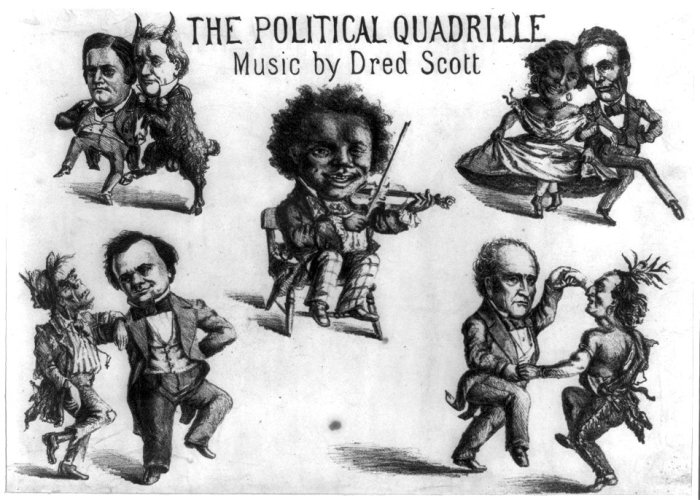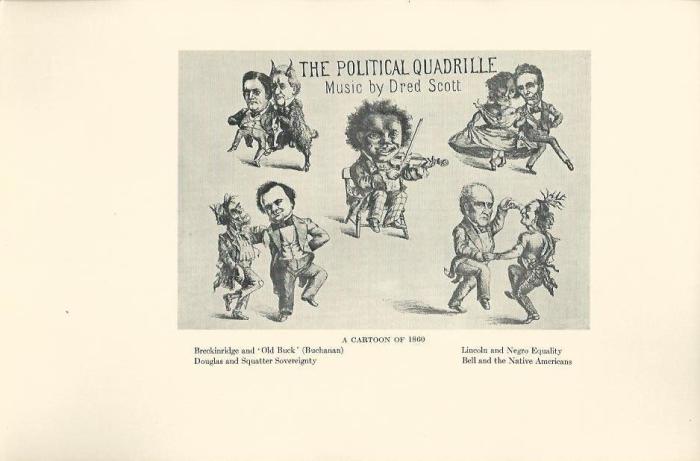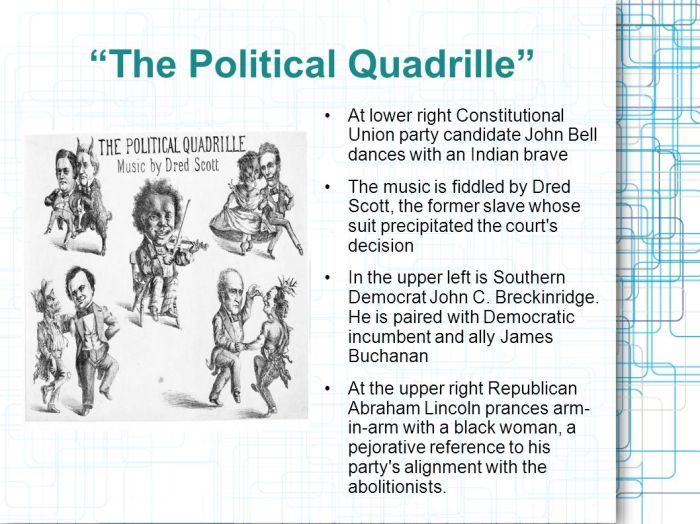The Political Quadrille Music by Dred Scott delves into the fascinating intersection of music, politics, and history. This piece, composed by Dred Scott, a former slave who gained national recognition through his legal case, offers a unique perspective on the tumultuous era of the 1850s in the United States.
The quadrille, a popular dance at the time, provided a clever and subtle medium for political commentary. Scott’s composition, with its intricate musical structure and symbolism, conveyed powerful messages about slavery, freedom, and the fight for justice.
The Political Quadrille’s Historical Context: The Political Quadrille Music By Dred Scott

The quadrille, a lively and intricate dance originating in France during the 18th century, gained immense popularity in the United States in the 19th century. It became a staple of social gatherings and political events, serving as a platform for expressing political sentiments.
During the 1850s, the United States was embroiled in intense political turmoil over the issue of slavery. The quadrille became a potent tool for political satire, allowing composers and musicians to convey their views on the divisive topic.
One such composer was Dred Scott, an enslaved African American who gained notoriety for his landmark legal case against his enslaver. Scott’s personal experiences and the political climate of the time heavily influenced the composition of “The Political Quadrille.”
Dred Scott’s Role in the Composition
Dred Scott was born into slavery in Virginia in 1799. He was purchased by army surgeon John Emerson and taken to Missouri, a slave state, in 1834. Scott lived in free territories for several years, but after Emerson’s death, his widow claimed him as her property.
Scott sued for his freedom, arguing that his residence in free territories made him a free man. The case went all the way to the Supreme Court, which ruled against Scott in 1857. The Dred Scott decision was a major blow to the abolitionist movement and further inflamed tensions between the North and South.
Scott’s experiences as an enslaved person and his legal battle for freedom deeply influenced the composition of “The Political Quadrille.” The piece is filled with symbolism and hidden messages that critique slavery and the political system that upheld it.
Musical Analysis of “The Political Quadrille”
“The Political Quadrille” is a complex and sophisticated musical composition that incorporates elements of classical, folk, and popular music. The piece is structured in five movements, each with a distinct tempo and mood.
The first movement, “The Grand March,” is a stately and dignified march that sets the tone for the rest of the piece. The second movement, “The Waltz,” is a more lyrical and romantic movement that provides a contrast to the first movement.
The third movement, “The Polka,” is a lively and energetic dance that represents the growing political tensions of the time. The fourth movement, “The Schottische,” is a more somber and reflective movement that foreshadows the coming Civil War.
The fifth and final movement, “The Galop,” is a fast and furious dance that represents the chaos and violence of the Civil War. The piece ends with a triumphant coda that symbolizes the Union victory and the abolition of slavery.
Impact and Legacy of “The Political Quadrille”, The political quadrille music by dred scott
“The Political Quadrille” was a major cultural phenomenon that had a profound impact on public opinion and political discourse. The piece was widely performed throughout the United States and became a rallying cry for abolitionists and other opponents of slavery.
The quadrille also played a role in shaping the American Civil War. The piece’s stirring melodies and powerful symbolism helped to galvanize support for the Union cause and inspired soldiers to fight for freedom.
The legacy of “The Political Quadrille” continues to this day. The piece is still performed by orchestras and choirs around the world, and it remains a powerful symbol of resistance and political expression.
Modern Interpretations and Adaptations
“The Political Quadrille” has been adapted and reinterpreted by numerous artists over the years. In 1942, the piece was arranged for orchestra by composer Leonard Bernstein. Bernstein’s arrangement is more modern and accessible than the original, and it has helped to introduce the quadrille to a new generation of listeners.
In recent years, “The Political Quadrille” has been used in a variety of contexts, including film, television, and theater. The piece has been featured in films such as “Lincoln” (2012) and “12 Years a Slave” (2013), and it has been performed on television shows such as “The Colbert Report” and “The Daily Show.”
The quadrille’s enduring popularity is a testament to its power and relevance. The piece continues to resonate with audiences today, and it remains a powerful symbol of resistance and political expression.
Commonly Asked Questions
What is the significance of the quadrille as a form of political satire?
The quadrille, a social dance, provided a discreet and socially acceptable way to express political views during a time of heightened political tensions.
How did Dred Scott’s personal experiences influence the composition of “The Political Quadrille”?
Scott’s experiences as a slave and his legal battle for freedom deeply informed the music’s themes of oppression, resistance, and the search for justice.
What are some of the musical elements that contribute to the tension and release in “The Political Quadrille”?
The use of contrasting tempos, melodic shifts, and harmonic progressions creates a sense of tension and release, reflecting the emotional rollercoaster of the era.




